What Insects Do Garden Frogs Eat?
A Guide to Amphibian Diets
Garden frogs are fascinating creatures that play a vital role in controlling insect populations. These amphibians have a diverse diet that includes various bugs and creepy crawlers. Garden frogs eat insects like flies, moths, beetles, and mosquitoes.
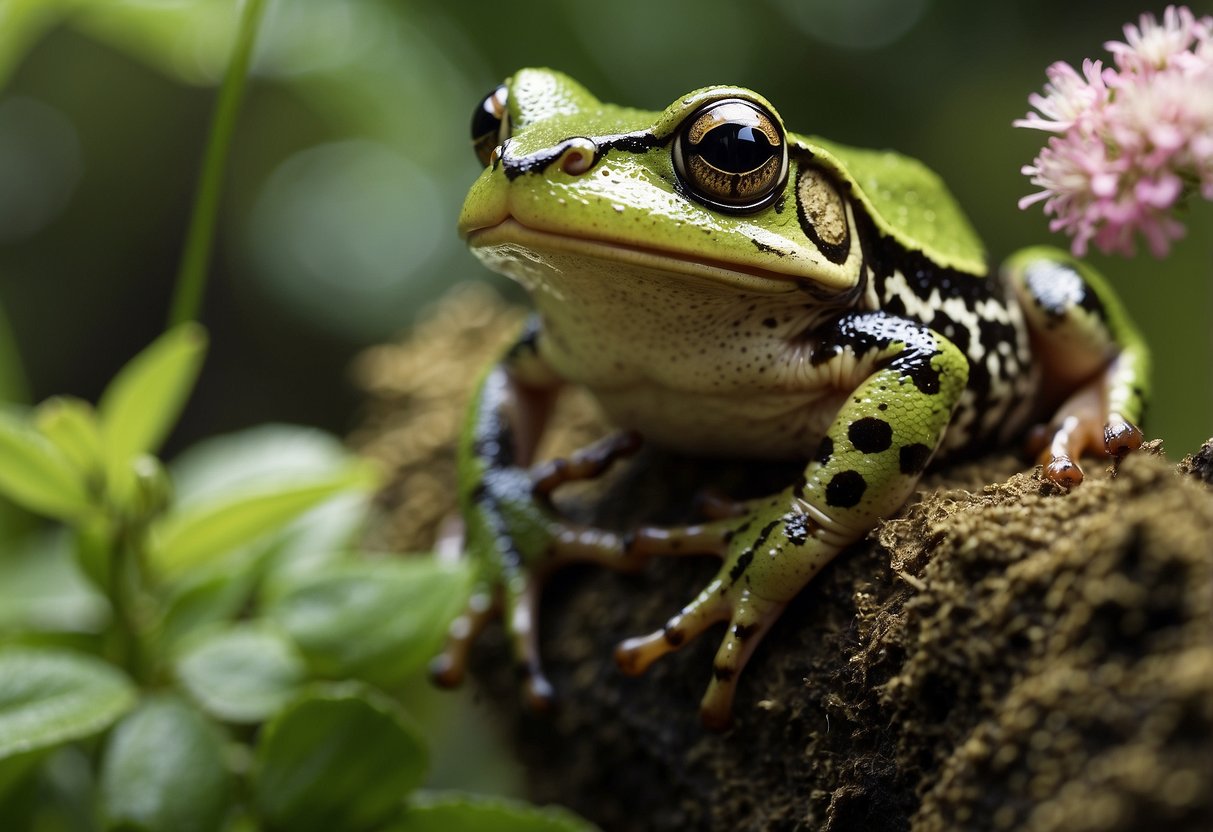
Frogs are opportunistic eaters and will consume any insect small enough to fit in their mouths. Their diet can vary based on factors such as frog size, habitat, and available prey.
Larger frog species may even eat small fish or snakes, while smaller frogs tend to focus on tiny insects like ants and fruit flies.
By eating insects, frogs help maintain a natural balance in gardens and ecosystems. They can be great allies for gardeners by keeping pest populations in check. Frogs use their long, sticky tongues to catch prey quickly and efficiently.
Key Takeaways
- Garden frogs eat a wide variety of insects, including flies, beetles, and mosquitoes.
- Frog diets vary based on species size, habitat, and available prey.
- Frogs help control insect populations in gardens and ecosystems.
Dietary Habits of Garden Frogs
Garden frogs are carnivorous creatures with diverse eating habits. They mainly feed on small insects and other invertebrates found in their habitat.
Common prey items for garden frogs include:
- Flies
- Mosquitoes
- Beetles
- Moths
- Ants
- Spiders
- Worms
- Slugs
Garden frogs use their long, sticky tongues to catch prey. They strike quickly, snatching insects mid-flight or from nearby surfaces.
Small frogs eat ants, aphids, and fruit flies. As frogs grow larger, they can consume bigger prey like grasshoppers and small fish.
Frogs are opportunistic feeders, eating whatever fits in their mouths. Their diet changes based on available food sources in their environment.
Most garden frogs hunt at night when insects are active. They sit still and wait for prey to come close before striking.
Tadpoles have different diets than adult frogs. They primarily eat algae and plants in ponds before developing into carnivores.
Garden frogs play a crucial role in pest control. They help keep insect populations in check, making them valuable allies for gardeners.
Common Insects in a Frog’s Diet
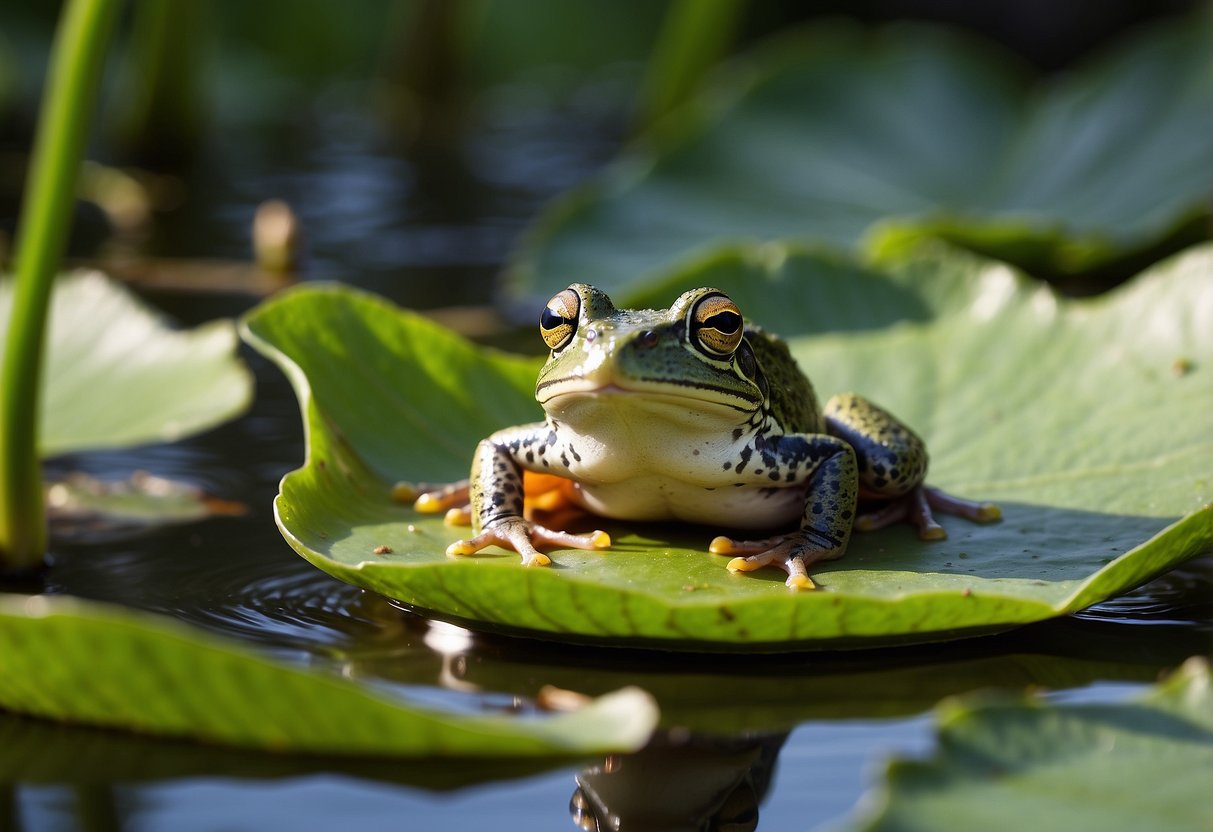
Garden frogs eat a variety of insects. They catch their prey using their long, sticky tongues. Frogs prefer moving targets and will eat almost any insect small enough to fit in their mouths.
Flies and Mosquitoes
Flies and mosquitoes are a major part of a frog’s diet. Frogs catch these insects with their quick, sticky tongues. They eat both adult flies and mosquitoes, as well as their larvae.
Fruit flies are popular prey for smaller frogs. Larger frog species can catch and eat bigger flies like house flies or blow flies.
Mosquitoes are a favorite food for many frogs. This makes frogs helpful in controlling mosquito populations in gardens and ponds.
Beetles
Beetles make up another important part of a frog’s diet. Water beetles are common prey for aquatic frogs. Land-dwelling frogs eat various types of ground beetles.
Smaller frog species target tiny beetles like ladybugs. Larger frogs can handle bigger beetles such as June bugs or click beetles.
Some frogs even eat fireflies, though they may avoid the bioluminescent parts. Beetle larvae are also on the menu for many frog species.
Caterpillars
Caterpillars are a nutritious food source for frogs. These soft-bodied insects are easy for frogs to catch and digest.
Frogs eat both smooth and hairy caterpillars. They don’t seem bothered by the defensive hairs some caterpillars have.
Many garden pest caterpillars end up as frog food. This includes tomato hornworms, cutworms, and cabbage loopers.
Frogs help control caterpillar populations in gardens. This makes them valuable allies for gardeners dealing with caterpillar infestations.
Ants
Ants are a staple food for many small frog species. Tiny frogs often specialize in eating ants and similar-sized insects.
Some frogs, like poison dart frogs, get their toxins from the ants they eat. Garden frogs aren’t poisonous but still enjoy dining on ants.
Frogs eat both worker ants and winged reproductive ants. They may gather near ant hills to catch flying ants during mating swarms.
Eating ants helps frogs control ant populations in gardens. This can be especially helpful with invasive ant species.
Factors Influencing Insect Consumption
Garden frogs eat a variety of insects, but several key factors affect what and how much they consume. These include the time of year, the specific frog species, and the environment they live in.
Seasonal Availability
Insect populations change throughout the year, impacting what frogs can eat.
In spring and summer, there are more insects around. This gives frogs a wider choice of food.
Flying insects like flies and mosquitoes are common during warmer months. Frogs take advantage of this abundance. They may catch these insects mid-air or snatch them from plants.
In fall and winter, insect numbers drop. Frogs have to adapt their diets. They might eat more ground-dwelling bugs like beetles or worms. Some frogs even eat smaller frogs or tadpoles when insects are scarce.
Frog Species Preferences
Different frog species have unique eating habits. This affects the types of insects they target.
Tree frogs often eat flying insects. Their sticky toe pads help them climb and catch prey in mid-air. Common tree frogs may eat only a few insects per day.
Ground-dwelling frogs like bullfrogs prefer larger prey. They might eat bigger insects such as grasshoppers or crickets. Some large species, like the African bullfrog, can eat up to 50 insects daily.
Smaller frog species often target tiny insects. They may eat ants, fruit flies, or small spiders.
Habitat Characteristics
A frog’s environment plays a big role in what insects it eats. Different habitats support various insect populations.
Ponds and wetlands attract water-loving insects. Frogs in these areas might eat more mosquitoes, dragonflies, and water striders.
Garden frogs often eat pests like slugs and caterpillars. This makes them helpful for keeping pest populations in check.
Frogs in forests or wooded areas may eat more beetles, moths, and spiders. These insects are common in leafy, shaded spots.
The amount of prey also matters. Frogs eat more in areas with lots of insects. In places with fewer insects, frogs might have to search harder for food.
Ecological Role of Frogs in Controlling Insect Populations
Frogs play a crucial part in keeping insect populations in check. These amphibians are voracious insectivores, eating large amounts of mosquitoes, flies, and other bugs.
Their appetite for insects helps maintain balance in ecosystems. By consuming pests, frogs protect both humans and crops from potential harm.
Frogs are especially good at controlling mosquito numbers. This makes them valuable allies in the fight against mosquito-borne diseases.
Some frogs eat up to 100 insects per night. This high consumption rate significantly impacts local insect populations.
Tadpoles also contribute to insect control. They feed on mosquito larvae in water, reducing future adult mosquito numbers.
Frogs’ role extends beyond just eating insects. Their presence or absence can indicate the health of an ecosystem. Scientists often look at frog populations to assess environmental conditions.
The relationship between frogs and insects is complex. Factors like habitat, climate, and predator-prey dynamics all influence how effectively frogs control insect numbers.
Conserving frog habitats is crucial. It ensures these natural pest controllers can continue their important work in ecosystems worldwide.
Feeding Behavior and Hunting Techniques
Garden frogs use two main strategies to catch insects. These methods help them find food efficiently in their environment.
Sitting and Waiting
Many garden frogs are ambush predators. They stay still for long periods, waiting for prey to come close.
Their colors help them blend in with leaves and grass. This camouflage makes it hard for insects to spot them.
When an insect gets near, the frog strikes quickly. It uses its sticky tongue to grab the prey. The tongue can extend far and retracts fast, pulling the insect into the frog’s mouth.
Frogs often pick spots near lights or water. These areas attract more insects, increasing the frog’s chances of catching food.
Active Hunting
Some frogs actively search for food instead of waiting. They hop around looking for insects to eat.
These frogs use their keen eyesight to spot moving prey. They can see well in low light, which helps them hunt at night.
Frogs may chase after fast insects like flies or beetles. They can jump quickly to catch their prey.
Some frogs even climb plants or trees to find insects. This lets them reach different types of bugs that don’t come to the ground.
Active hunters often eat a wider variety of insects. They might find ants, crickets, or spiders that don’t pass by waiting frogs.
Impact of Pesticides on Frog Diet
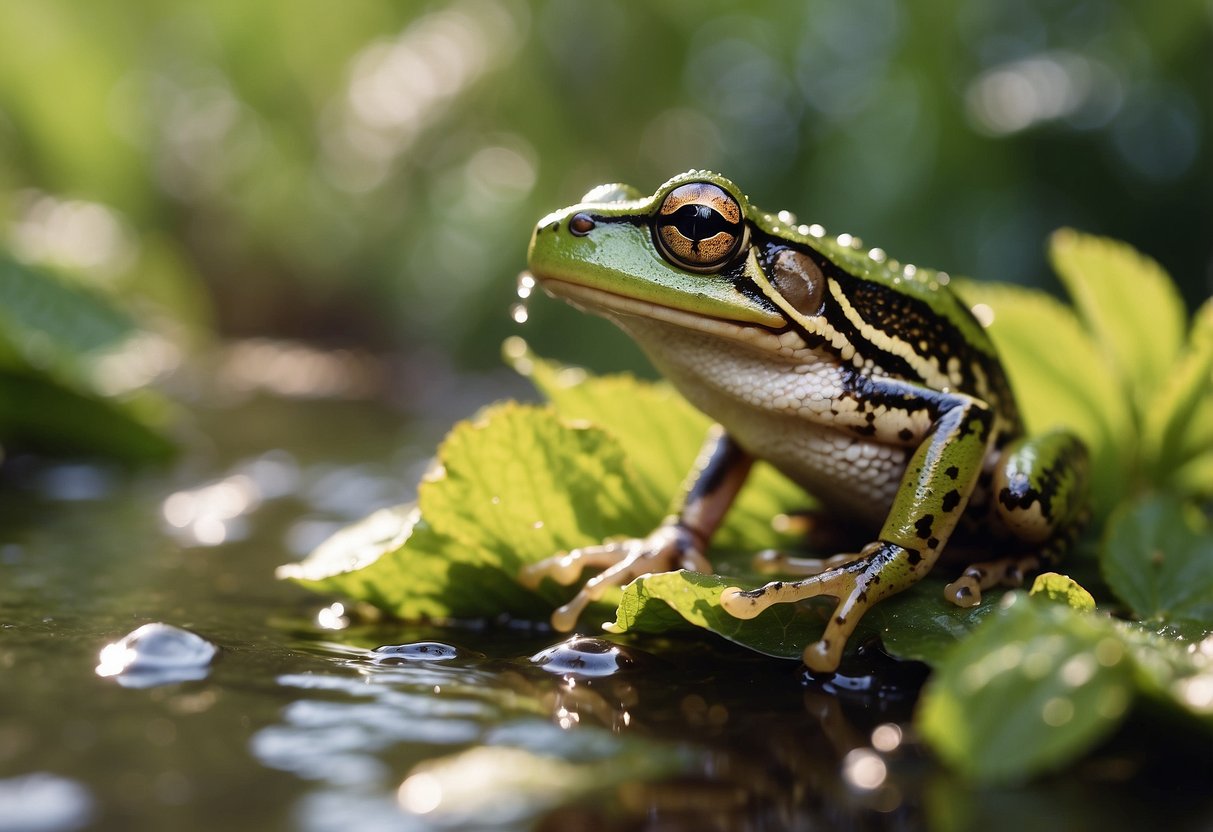
Pesticides can greatly affect what garden frogs eat. These chemicals are often used to kill insects, but they can harm frogs too.
When pesticides are sprayed, they can kill many of the insects frogs normally eat. This leaves frogs with less food. Frogs may have to search harder to find enough to eat.
Some frogs can increase their tolerance to pesticides within days. But this comes at a cost. Frogs use energy to deal with pesticides instead of finding food.
Pesticides can also make it harder for frogs to catch prey. Some chemicals affect frogs’ nervous systems. This can slow them down or make their movements less precise.
Frogs may absorb pesticides through their skin. Over time, this can build up in their bodies. It may make them sick or less able to hunt.
Garden frogs often eat both in water and on land. This means they can be exposed to pesticides in many places. Chemicals can wash into ponds and streams where frogs live and hunt.
To help garden frogs, people can:
- Use fewer pesticides
- Choose natural pest control methods
- Create pesticide-free areas in gardens
By protecting insects, we also protect the frogs that eat them.
Enhancing Garden Habitats for Frogs
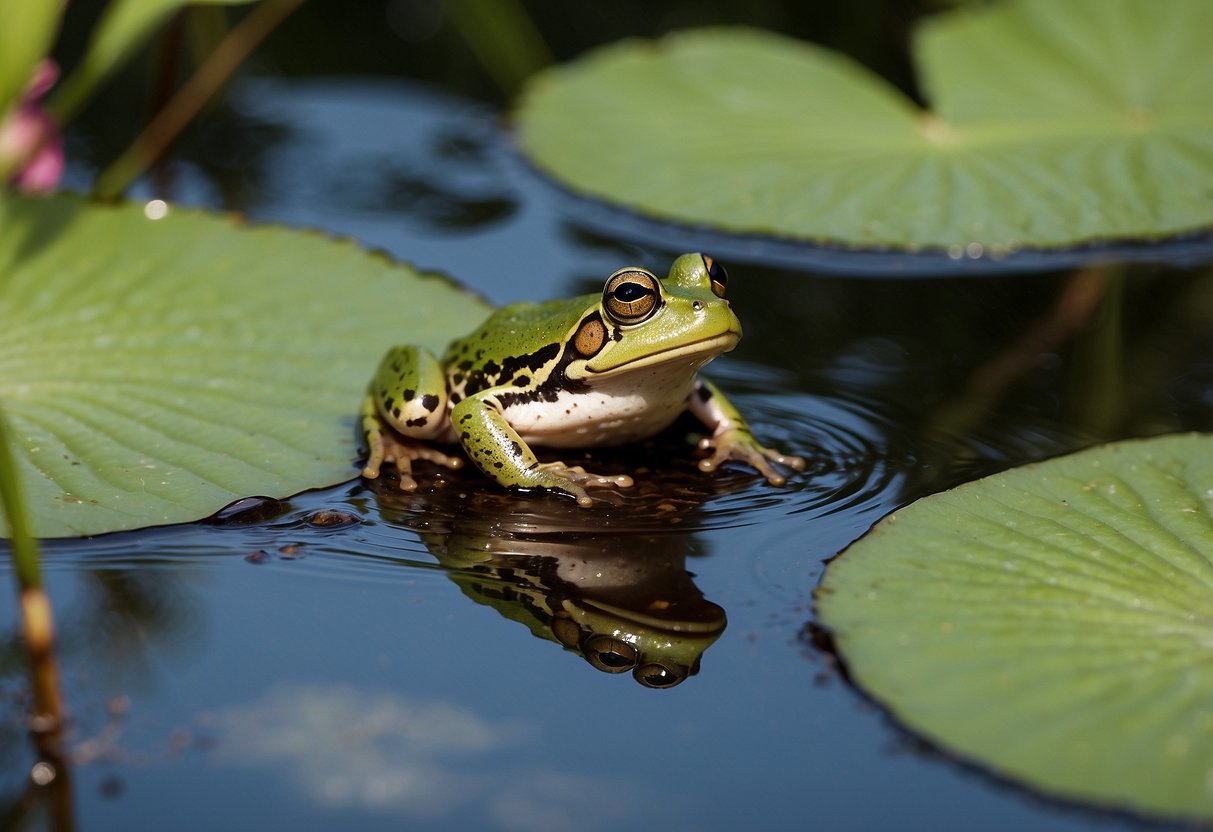
Frogs need specific features in a garden to thrive. A good frog habitat has water, shelter, and plenty of insects to eat. Let’s look at how to create these key elements.
Creating Ponds
Frogs need water to lay eggs and live. A garden pond is perfect for this. It doesn’t have to be big. Even a small water feature works well.
Make sure the pond has shallow areas. Frogs like to sit in shallow water. Add some rocks or logs for them to rest on.
Keep the water clean. Don’t use chemicals that could harm frogs. Native plants around the pond help keep it healthy. They also give frogs places to hide.
A pump can keep the water moving. This stops mosquitoes from breeding. But make sure there are still calm areas for frog eggs.
Providing Shelter
Frogs need places to hide from the sun and predators. They like cool, damp spots.
Add some logs or rocks near the pond. Frogs can hide under these. Leaf piles work well too. Don’t remove all the fallen leaves in your garden.
Plant some dense bushes or tall grasses. Frogs can hide in these during the day. Native plants are best. They fit well with the local environment.
Make a “toad house” out of an old flower pot. Turn it on its side and bury it halfway. This gives frogs a cool place to rest.
Plant Diversity and Insect Attraction
Frogs eat insects. To attract frogs, you need to attract insects first. A mix of plants helps with this.
Plant flowers that attract bugs. Bees, butterflies, and moths are all frog food. Native wildflowers are great for this.
Add some fruit trees or berry bushes. These attract flies and beetles. Frogs eat these too.
Use garden lights carefully. They can attract night insects for frogs to eat. But too much light can disturb frogs. Use low, warm lights if you need them.
Don’t use pesticides. These kill the insects frogs need to eat. They can also harm the frogs directly.
Frequently Asked Questions
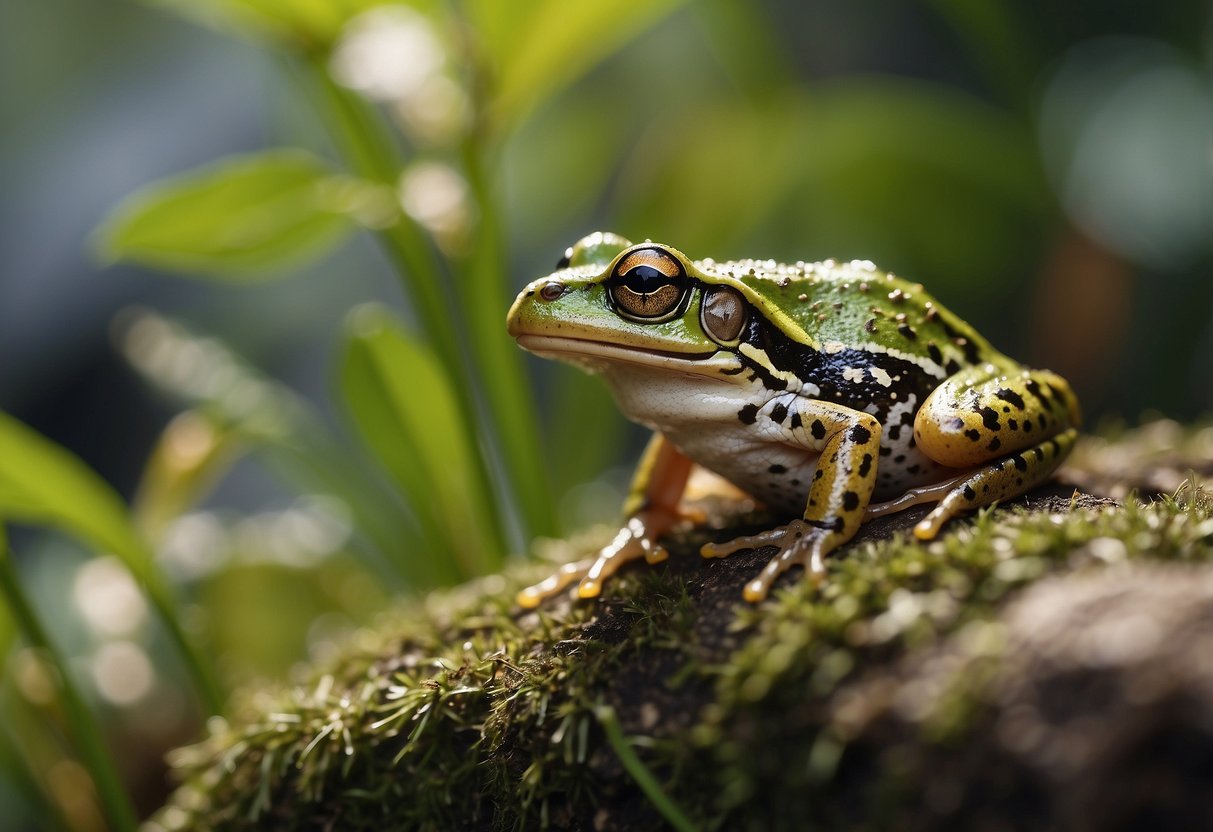
Garden frogs have diverse diets and play important roles in their ecosystems. Their food preferences and habits change with seasons and environments.
What varieties of insects are commonly consumed by garden frogs?
Garden frogs eat a wide range of insects. They catch flies, moths, and butterflies with their long, sticky tongues. Frogs also enjoy crickets, grasshoppers, and beetles.
Smaller frogs often target ants, aphids, and fruit flies. Some species even eat mosquito larvae, helping control pest populations.
How do the feeding habits of garden frogs change during winter?
In winter, many frogs become less active. They may enter a state of hibernation or brumation. During this time, frogs eat very little or not at all.
Some frogs burrow into mud or leaves to stay warm. Others find shelter in rock crevices or under logs. Their metabolism slows down, allowing them to survive on stored fat.
What are some non-insect food sources for garden frogs?
While insects make up most of a frog’s diet, they sometimes eat other small animals. Larger frogs may eat small fish, tadpoles, or even other frogs.
Some frogs catch spiders or worms. Very big frogs, like bullfrogs, might even eat small mice or snakes.
Can garden frogs benefit from having plants in their diet?
Adult frogs are carnivores and don’t eat plants. However, tadpoles often eat algae and other water plants. This plant-based diet helps tadpoles grow.
As tadpoles transform into frogs, their diet shifts to insects and small animals. Adult frogs don’t digest plant matter well, so they stick to meat.
What role do frogs play in maintaining a garden ecosystem?
Frogs are important for pest control in gardens. They eat many insects that can damage plants. This natural pest control helps keep the garden healthy.
Frogs also serve as food for other animals like birds and snakes. They help transfer energy through the food chain. Their presence indicates a balanced ecosystem.
What dietary preferences do frogs exhibit in aquatic environments like ponds?
In ponds, frogs eat water-dwelling insects and their larvae. They catch water beetles and mosquito larvae from the water’s surface.
Some aquatic frogs eat small fish or tadpoles. They may also catch insects that land on the water. Frogs in ponds often eat more aquatic prey than their land-dwelling cousins.
